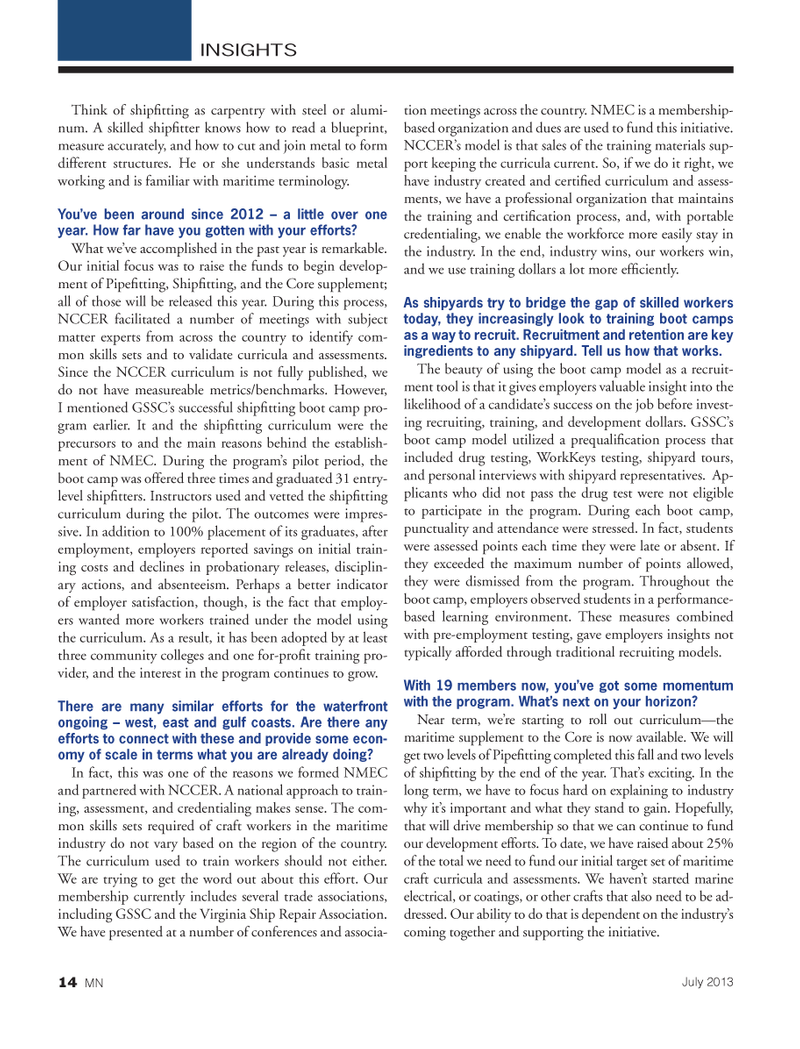
Page 14: of Marine News Magazine (July 2013)
Propulsion Technology
Read this page in Pdf, Flash or Html5 edition of July 2013 Marine News Magazine
INSIGHTSThink of ship? tting as carpentry with steel or alumi- num. A skilled ship? tter knows how to read a blueprint, measure accurately, and how to cut and join metal to form different structures. He or she understands basic metal working and is familiar with maritime terminology. Youve been around since 2012 ? a little over one year. How far have you gotten with your efforts? What weve accomplished in the past year is remarkable. Our initial focus was to raise the funds to begin develop- ment of Pipe? tting, Ship? tting, and the Core supplement; all of those will be released this year. During this process, NCCER facilitated a number of meetings with subject matter experts from across the country to identify com- mon skills sets and to validate curricula and assessments. Since the NCCER curriculum is not fully published, we do not have measureable metrics/benchmarks. However, I mentioned GSSCs successful ship? tting boot camp pro- gram earlier. It and the ship? tting curriculum were the precursors to and the main reasons behind the establish- ment of NMEC. During the programs pilot period, the boot camp was offered three times and graduated 31 entry- level ship? tters. Instructors used and vetted the ship? tting curriculum during the pilot. The outcomes were impres- sive. In addition to 100% placement of its graduates, after employment, employers reported savings on initial train- ing costs and declines in probationary releases, disciplin- ary actions, and absenteeism. Perhaps a better indicator of employer satisfaction, though, is the fact that employ- ers wanted more workers trained under the model using the curriculum. As a result, it has been adopted by at least three community colleges and one for-pro? t training pro- vider, and the interest in the program continues to grow. There are many similar efforts for the waterfront ongoing ? west, east and gulf coasts. Are there any efforts to connect with these and provide some econ- omy of scale in terms what you are already doing? In fact, this was one of the reasons we formed NMEC and partnered with NCCER. A national approach to train- ing, assessment, and credentialing makes sense. The com- mon skills sets required of craft workers in the maritime industry do not vary based on the region of the country. The curriculum used to train workers should not either. We are trying to get the word out about this effort. Our membership currently includes several trade associations, including GSSC and the Virginia Ship Repair Association. We have presented at a number of conferences and associa- tion meetings across the country. NMEC is a membership- based organization and dues are used to fund this initiative. NCCERs model is that sales of the training materials sup- port keeping the curricula current. So, if we do it right, we have industry created and certi? ed curriculum and assess- ments, we have a professional organization that maintains the training and certi? cation process, and, with portable credentialing, we enable the workforce more easily stay in the industry. In the end, industry wins, our workers win, and we use training dollars a lot more ef? ciently. As shipyards try to bridge the gap of skilled workers today, they increasingly look to training boot camps as a way to recruit. Recruitment and retention are key ingredients to any shipyard. Tell us how that works. The beauty of using the boot camp model as a recruit- ment tool is that it gives employers valuable insight into the likelihood of a candidates success on the job before invest- ing recruiting, training, and development dollars. GSSCs boot camp model utilized a prequali? cation process that included drug testing, WorkKeys testing, shipyard tours, and personal interviews with shipyard representatives. Ap- plicants who did not pass the drug test were not eligible to participate in the program. During each boot camp, punctuality and attendance were stressed. In fact, students were assessed points each time they were late or absent. If they exceeded the maximum number of points allowed, they were dismissed from the program. Throughout the boot camp, employers observed students in a performance- based learning environment. These measures combined with pre-employment testing, gave employers insights not typically afforded through traditional recruiting models. With 19 members now, youve got some momentum with the program. Whats next on your horizon? Near term, were starting to roll out curriculum?the maritime supplement to the Core is now available. We will get two levels of Pipe? tting completed this fall and two levels of ship? tting by the end of the year. Thats exciting. In the long term, we have to focus hard on explaining to industry why its important and what they stand to gain. Hopefully, that will drive membership so that we can continue to fund our development efforts. To date, we have raised about 25% of the total we need to fund our initial target set of maritime craft curricula and assessments. We havent started marine electrical, or coatings, or other crafts that also need to be ad-dressed. Our ability to do that is dependent on the industrys coming together and supporting the initiative. 14 MNJuly 2013MN July2013 Layout 1-17.indd 146/28/2013 9:51:14 AM

 13
13

 15
15
